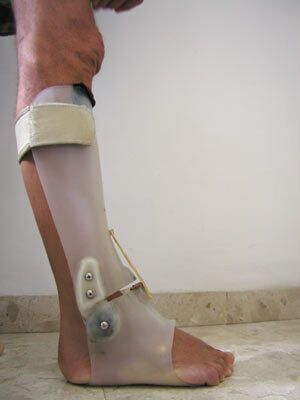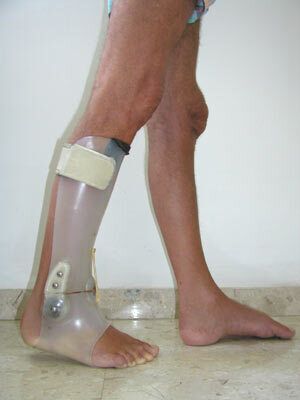Safe Mobility - AFO
A Precious Function
David H. Gershuni M.D. (Individual living with KD)
Professor Emeritus, University of California, San Diego.
(The following is being made available to associates and readers of the KDA Web site for information purposes only. The KDA does not and cannot make any medical endorsements, nor statements.)
It is vital that we make every effort, use every aid, device and trick to maintain our mobility, but do so in a safe and sensible fashion. Immobility certainly may prevent falling but introduces new problems to all of our systems. Thus, cardiovascular, respiratory and gastrointestinal functions decrease, urinary and kidney problems may arise, bones weaken from disuse (osteoporosis), weight often increases, skin at pressure points may break down and there are possibilities of social and mood changes. These issues can be as traumatic as accidents of mobility; the latter however, can mainly be avoided.
Falling is a major hazard for us and in particular can result in head and neck injuries (especially when we fall backwards), fractures, joint dislocations, and muscle or ligamentary tears of the limbs and back. The consequences may be temporary loss of mobility, the need for splinting or casting, or even hospitalization and surgery. The treatment is prevention.
To comprehend the problem, prior to addressing prevention, it is helpful to know some of the background to falling accidents particularly in a person with Kennedy’s Disease.
There is a significant difference as to how we use our upper and lower limbs. Activities with arms and hands are largely intentional and non-reflexive; walking however is automatic and reflexive. This means that we do not normally pay attention to our legs during walking and, if there is a problem of irregular, unstable ground or change of slope, our muscles make automatic, corrective adjustments mostly by reflex and non-conscious contractions.
If however, we have weak or non-existent muscles such reflex muscle actions just cannot occur and the result is frequently loss of balance and a fall. The loss of balance is not related to any deficiency of sensation as to where our limbs are positioned in space or whether our feet are touching ground or are in the air, but purely because the normal reflex, corrective stimuli transmitted by the nerves do not find a responsive muscle to contract and help us regain balance. In technical terms the problem in the spinal reflex arc is motor and not sensory.
My experience has shown me that during walking KD individuals have two major susceptibilities in the lower limbs.
The first is the tendency for the ankle to twist inward (inversion). Without corrective muscle contraction to counteract the twist, the result is injury to the ligament on the outer side of the ankle or a fracture of the ankle and inevitably a fall causing further injury to another part of the body. Prevention of this problem is to avoid terrain that is irregular (stony) or unstable (turf or sand) or walking across a slope. High top boots or a protective brace (orthosis), a cane or a friendly arm for balance, can also be helpful to avoid ankle injury.
The second major susceptible joint is the knee which “gives way”. The essence of the problem here is weakness of the quadriceps muscle which lies on the front of the thigh and attaches that bone to the knee-cap and through it to the upper end of the shin bone. The quadriceps is the major muscle stabilizer of the knee; it helps to extend the leg at the knee and locks the joint into the stable, straight weight-bearing position.
If while walking, a toe becomes caught in a carpet, a divot or stone the effect will be transmitted up the leg to flex the knee when it should be extending prior to weight-bearing on that leg. The normal protective, reflex contraction stimulus to the quadriceps occurs but the weak muscle cannot respond strongly enough to correct the problem; the knee gives way and down we go.
Prevention in this case starts with shoe-ware that is light weight, so as not to accentuate the tendency to dropping of the foot due to weak, upward pulling muscles. Paying attention to the terrain in the house or outdoors is critical. Holding a cane in the hand on the side of the weaker leg, or the opposite hand to a weak hip, can be very helpful.
A variation of the knee problem can occur on climbing stairs. In this case the knee, of the leg just planted on a step, has not been fully extended or locked because of a weak quadriceps muscle. When the other foot is then lifted from the lower step, the upper knee collapses and gravity takes over to cause a very dangerous backward fall. Descending stairs can also be dangerous but here gravity is more helpful in straightening the knee of the leading leg before planting the foot on the lower step.
Prevention in this case is always to start ascending stairs with a good grip on at least one handrail. If a second handrail is not available a cane is a useful substitute. Then, making sure one leg is firmly planted on the upper step with the knee locked straight, carefully throw your upper body weight forward to passively lock the knee even more securely, before raising the trailing leg. This means stair climbing should not be automatic but a planned, mindful action.
I have used a brace, to help lock the knee of my weaker leg, which succeeded for more than seven years in keeping me mobile, vertical (without the need for a cane) and safe on the flat, up and down slopes & on stairs. I demonstrated the brace in Baltimore last year and am showing 3 views of it here. (See below).
The brace is designed in foot and leg sections hinged at the ankle, with one Velcro strap for fixation around the upper calf. The hinges allow free, downward foot flexion but upward foot movement is blocked, by contact of leather pads at the front parts of the 2 polypropylene sections, at about 10 degrees short of 90 degrees. The required and inevitable effect is to drive the upper part of the leg section against the shinbone when the foot of that side becomes weight-bearing; this backward force on the shin below the knee then passively back-locks the knee.
Fig. A. The foot is planted but the front sections are not making contact

Fig. B. Front view with elastic band spanning the gap

Fig. C. The front leather pads are in contact; now the heel can only touch the floor if the upper part of the brace drives the shin backwards and locks the knee.

The brace is quite light in weight but it takes up space in the shoe and can snag the pant leg if the front elastic band is not used. The brace also has some stabilizing and protective effect on the ankle. A knowledgeable Orthopaedic Orthotist should be able to custom make one to your foot and leg shape and fine tune the position of blocking at the ankle (the dorsiflexion block). It is important to note that this brace is NOT the common AFO or ankle-foot-orthosis whose function is essentially to counteract “foot drop”. Understanding the physiology of walking and possible use of various walking aids can thus allow mobility to be maintained for many years to keep us functional, happy and safe without the stresses of enforced immobility. [The brace was made for me by Randy Mason CP, Rehab Designs, San Diego. Tel: 858 277 7318].

